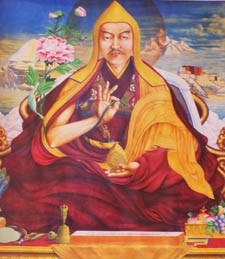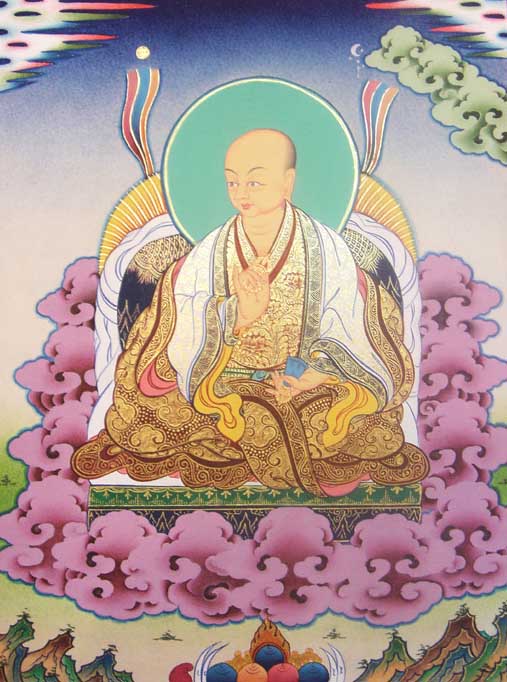Dalai Lama Ngawang Lobsang Gyatso
ཏ་ལའི་བླ་མ་ངག་དབང་བློ་བཟང་རྒྱ་མཚོ།
ta la'i bla ma ngag dbang blo bzang rgya mtsho
Short biography[edit]
- 1617-1682 [JV]
- Dalai lama v - (1617-1682) [RY]
- Dalai lama v (1617-1682) [RY]
- 1617-1682 - fifth Dalai Lama, Ngawang Lobzang Gyatso [RY]
--
Gyalwang Rinpoche, The Great Fifth Dalai Lama (1617-1682), is a towering figure in Tibetan history, renowned for both His temporal and spiritual accomplishments.
The boy who would become known as the Great Fifth Dalai Lama was born in 1617 to a family with strong ties to the Drukpa Kagyu school. While still young, He was recognized by the first Panchen Lama as the reincarnation of the 4th Dalai Lama, given the name Lobsang Gyatso and installed at Drepung Monastery. His training began shortly thereafter. Under the guidance of several teachers He received a thorough education and went on to write extensively of Buddhist philosophy and the other traditional fields of knowledge. His collected writings total twenty-six volumes while His pure visions fill another two.
During His youth, Tibet was in turmoil. Following the collapse of the early Tibetan dynasty in the ninth century, political authority devolved into the hands of local lords. The lands of central Tibet remained divided until the thirteenth century, when Mongol hordes overran Tibet. Mongolians were to remain an important force in Tibetan politics for the next few centuries. In 1261, Godan Khan, the grandson of Genghis Khan, transferred power to the Sakya hierarch Drogon Chogyal Phakpa. Yet his successors would rule for just over fifty years before being overthrown by the Phakmo Drupas. They in their turn were displaced by the Rinpung administration, who later fell at the hands of the prince of Tsang in 1565.
In 1635, unrest erupted into civil war as rival Mongolian factions threw their support behind competing Tibetan camps. Eventually, the forces of Gushri Khan defeated the Chogthu Mongols and their allies, the administration of Tsang. Thus it was that in 1642, the twenty-five year old Dalai Lama was installed as the spiritual and temporal leader of Tibet. His reign, like His spiritual predilections, was notable for the diversity of its achievements: Under Him, the arts and sciences enjoyed generous patronage. His authority was acknowledged by the Manchu rulers of China. He established the dralha of Nechung as an official State Oracle. He recognized Lobzang Chokyi Gyaltsen as an incarnation of Amitabha and reserved the title ‘Panchen Lama’ for him and his incarnations. He built the Naga Palace with its exquisite murals depicting esoteric Dzogchen practices and restored the ancient imperial palace on Marpo Ri to create the famous Potala Palace of today.
From this brief list, one can see how the Great Fifth Dalai Lama was, in the words of E. Gene Smith, “a tolerant prince with a well-developed eclectic bent of mind.” He went to great lengths to reconcile the conflicts of the previous centuries and His commitment to the other Tibetan schools is well-attested in the relationships He cultivated with important lamas in the Sakya school and the various Kagyu denominations.
Yet His abiding interest lay with the Nyingma School. He received the transmissions for the Nyingma Kama from Zurchen Choying Rangdrol and was known as a dedicated practitioner of the Northern Treasures revealed by Rigdzin Godem. While in retreat on the Dynamic Energy of Vajra Wrath, the secret mind sadhana of the Northern Treasures, the Fifth Dalai Lama experienced a series of pure visions. With the help of His scribe and secretary Gelong Jamyang Drakpa, He recorded these as the Pure Visions Sealed with Secrecy.
To the enduring benefit of the Nyingma teachings, the Great Fifth forged a relationship with Minling Terchen Gyurme Dorje. Gyurme Dorje, then only eleven years old, received his first monastic vows from the Great Fifth and went on to become the great terton, or revealer of hidden treasures, known as Terdak Lingpa. Terdak Lingpa regarded the Great Fifth as one of his two main teachers while the Great Fifth in turn received many empowerments and transmissions from Terdak Lingpa. In 1676, with patronage from the Great Fifth, Terdak Lingpa founded Orgyen Mindroling Monastery. From that time up to the present, Mindroling has performed rituals for the wellbeing of the Tibetan government under the Dalai Lama.
Though the Great Fifth Dalai Lama passed away in 1682 at the age of sixty-six, His influence is still felt, both in the spiritual and temporal realms.
Literary Works[edit]
Main Teachers[edit]
Main Students[edit]
Main Lineages[edit]
Alternate Names & Spellings[edit]
- The Great 5th Dalai Lama
- Zilnon Draktsal Dorje
- Ngawang Lobsang Gyatso, Ngawang Lozang Gyatso, Ngawang Lobzang Gyamtso
- rgyal dbang lnga pa chen po ngag dbang blo bzang rgya mtsho
Other Resources[edit]
- rgyal rabs lo tshigs shes bya mang 'dus mkhas pa'i spyi nor
- bod rig pa'i tshig mdzod chen mo shes bya rab gsal
- Secret Visions of the Fifth Dalai Lama: Translated by Samten Karmay[1]
- Rise of Esoteric Buddhism in Tibet: By Eva K. Neumaier-Dargyay
- Lhasa in the Seventeenth Century: By Françoise Pommaret-Imaeda
- Meditation on Emptiness: By Jeffrey Hopkins, Elizabeth Napper (this book contains many many quote from the vast corpus of the Great 5th's writings)

